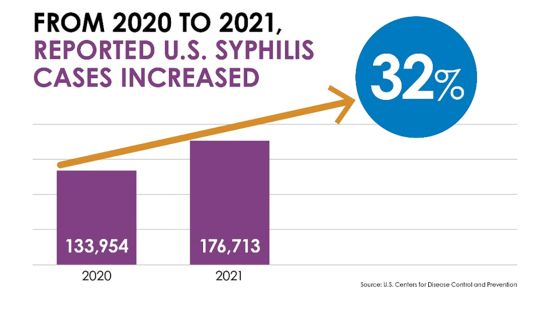
|
Press Release
April 11, 2023
U.S. STI Epidemic Showed No Signs of Slowing in 2021 – Cases Continued to Escalate
Español (Spanish)
Reported cases of the sexually transmitted infections (STIs) chlamydia, gonorrhea, and syphilis all increased between 2020 and 2021 – reaching a total of more than 2.5 million reported cases – according to CDC’s final surveillance data. To reverse this trend, CDC is calling for more groups from local, healthcare, industry, and public health sectors to contribute to STI prevention and innovation efforts.
The new report provides final surveillance data for 2021, and shows that overall in a single year (2020-2021):
- Gonorrhea rates increased more than 4%
- Syphilis rates surged, increasing nearly 32% for combined stages of the infection
- Among the syphilis data, cases of congenital syphilis rose by an alarming 32% and resulted in 220 stillbirths and infant deaths.
- Chlamydia rates increased nearly 4%, but – unlike gonorrhea and syphilis – still did not return to pre-pandemic levels
- This raises concerns that screening continued to be impacted by COVID-19 related disruptions the second year of the pandemic, because the infection is often asymptomatic.

While STIs are common in all U.S. regions and across all groups, some communities are hit especially hard. The 2021 data show STIs continue to disproportionately affect gay and bisexual men and younger people. Additionally, a disproportionate number of cases were diagnosed among Black/African American and American Indian/Alaska Native people, groups more likely to face social conditions that make it more difficult to stay healthy.
The nation must deepen its commitment to turn the STI epidemic around and prioritize both the increased involvement of multisectoral programs and groups and the creation of innovative prevention approaches and promising new tools. This means:
- Rebuilding, sustaining, and expanding local public health services, especially efforts to offer STI testing and treatment programs that respond to the needs of those most affected.
- Making STI testing and treatment more accessible, including through the development and approval of point-of-care rapid tests and self-tests, and by expanding ownership for STI testing and treatment to more organizations and settings.
- Continuing to advance scientific research and explore new interventions, like vaccines or post-exposure prophylaxis (PEP) strategies to prevent bacterial STIs.
Please attribute the following quote to Leandro Mena, MD, MPH, Director of CDC’s Division of STD Prevention
“The U.S. STI epidemic shows no signs of slowing. The reasons for the ongoing increases are multifaceted – and so are the solutions. For the first time in decades, we’re seeing promising new STI interventions on the horizon, but these alone will not solve this epidemic. It will take many of us working together to effectively use new and existing tools, to increase access to quality sexual healthcare services for more people, and to encourage ongoing innovation and prioritization of STI prevention and treatment in this country.”
U.S. DEPARTMENT OF HEALTH AND HUMAN SERVICES
CDC works 24/7 protecting America’s health, safety and security. Whether diseases start at home or abroad, are curable or preventable, chronic or acute, or from human activity or deliberate attack, CDC responds to America’s most pressing health threats. CDC is headquartered in Atlanta and has experts located throughout the United States and the world.
Contact:
Media Relations
(404) 639-3286
Source: Centers for Disease Control and Prevention https://www.cdc.gov/media/releases/2023/s0411-sti.html
For more HIV and AIDS News visit...
Positively Positive - Living with HIV/AIDS:
HIV/AIDS News
|